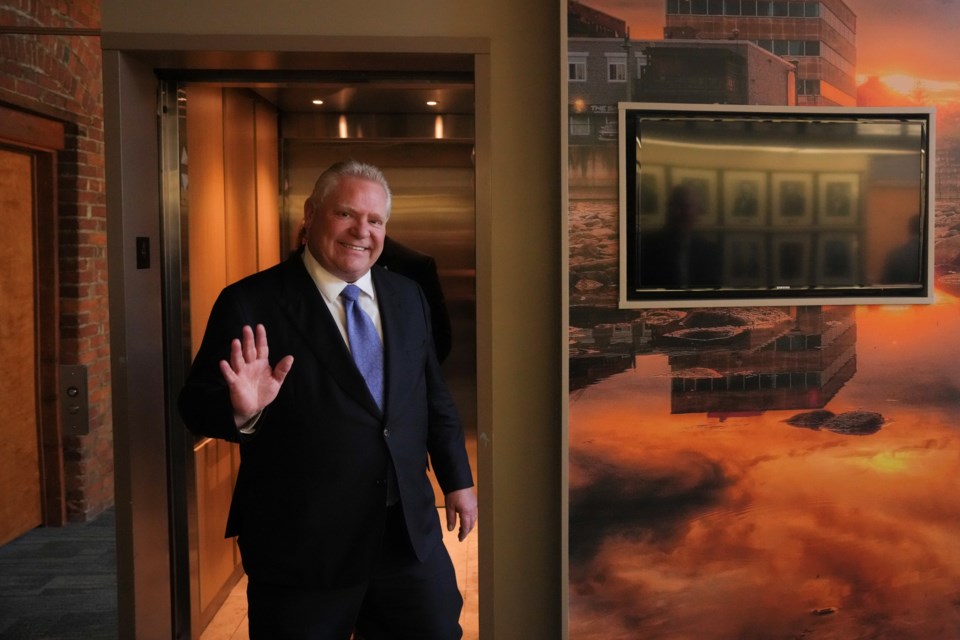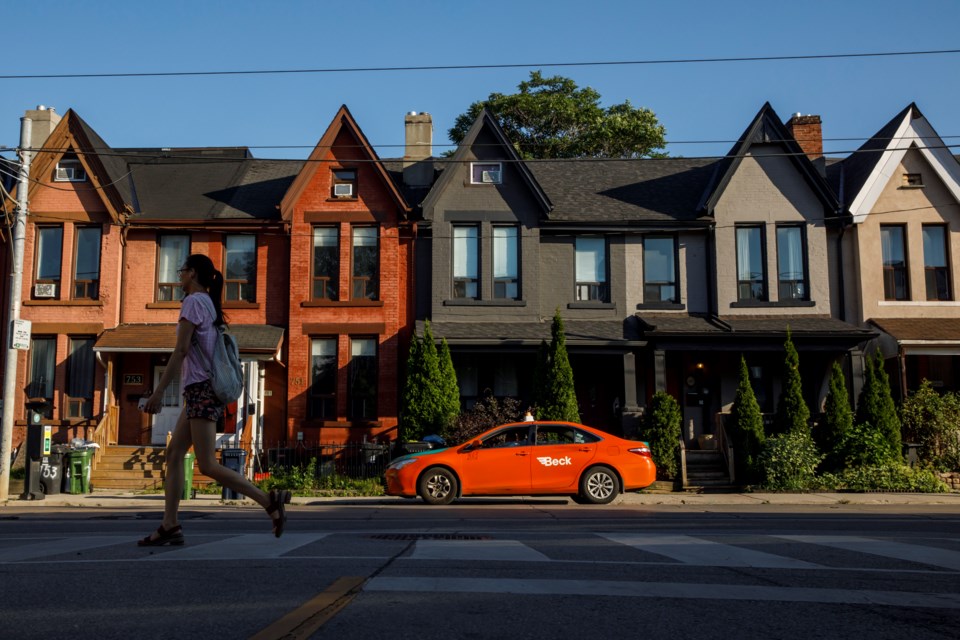EDITOR’S NOTE: This article originally appeared on The Trillium, a Village Media website devoted exclusively to covering provincial politics at Queen’s Park
Housing is one of the top political issues across the country, but especially in Ontario —where the average home price has more than doubled in less than a decade.
Every level of government is trying to do something and claim credit.
Ontario Premier Doug Ford won a majority promising to "get it done" and build 1.5 million homes by 2031. The Tories promised an annual “housing supply action plan” to tackle the problem. The next housing bill is coming “very soon,” according to Housing Minister Paul Calandra, and many advocates are waiting with bated breath.
In Ottawa, the federal Liberals are clinging to a minority and fending off attacks from the surging Conservatives that they're the reason homes are so unaffordable in the first place. To combat that criticism, they’ve made their Housing Accelerator Fund a key priority, sending Minister Sean Fraser to towns and cities across the country to meet glad-handing local politicians and announce federal dollars in exchange for less restrictive zoning laws.
So, who's actually getting it done, if anyone?
White picket fences
For decades, most Ontario neighbourhoods have been dominated by single-family homes. Tall towers went up in areas where zoning bylaws would permit, but smaller apartments — like those common in Montreal — were few and far between.
That became a big problem as the province’s population skyrocketed. Too many people and not enough places to live near job centres.
Demand was outpacing supply.
Ontario’s planning policies didn’t evolve to accommodate the growth, leading to staggering price increases. More dense forms of housing like apartments and multiplexes — which cost less — weren’t allowed in most of the province without a long, arduous and expensive rezoning process.
Politicians began to respond as first-time homebuyers became locked out of the market and rents shot to new highs.
The Ford government commissioned an expert panel to make recommendations on how to solve the problem. One of the main takeaways was that the province needs to take charge and allow multiplexes — four unit, four-storey (or more) buildings on a single lot — without the need to go through the complicated rezoning process.
Former housing minister Steve Clark took some steps to respond to the report. Bill 23, the Ford government’s biggest housing bill to date, legalized triplexes across Ontario and made several other changes intended to lower the cost of building and speed up approvals.
In the year-and-a-half since the bill dropped, housing advocates are still waiting for the elusive multiplex legalization to come through.
Enter Sean Fraser.
When he was shuffled from immigration to infrastructure last summer, he took a promising but underutilized program by the horns and began to reshape Ontario’s housing landscape.
The $4 billion Housing Accelerator Fund was a promise from the Liberals’ 2021 election platform. Its initial goal was to build 100,000 new homes by “increasing densification, speeding-up approval times, tackling NIMBYism (not-in-my-backyardism) and establishing inclusionary zoning bylaws, and encouraging public transit-oriented development.”
Ottawa doesn’t have jurisdiction over planning policy. That falls squarely on provincial and municipal governments. The fund leverages the power of the federal purse to essentially bribe cities to legalize density.
In the eight months since Fraser’s been on the job, he’s shaken hands with 19 mayors across Ontario and committed over $1.3 billion in funding. The Canada Mortgage and Housing Corporation estimates the agreements will lead to nearly 370,000 homes over 10 years, according to data provided to The Trillium.
The fund has “dramatically exceeded” Fraser’s high expectations, he said on a recent podcast with Liberal MP Nathaniel Erskine-Smith.
Over half of Ontario’s population now lives in cities that have legalized multiplexes.
The agreements all follow a similar mould. More density everywhere, particularly around transit. Faster planning approvals and a less cumbersome process. Using city-owned lands for affordable housing development. They mirror the recommendations from Ontario’s task force.
While many housing advocates are big fans of the program, some say it doesn’t go far enough — and can’t go far enough, given the jurisdictional constraints. They credit Fraser for doing what he can with what he has — and for using his bully pulpit to bring the often jargon-filled housing conversation to Canada’s kitchen tables — but say the experience highlights the need for more provincial action on the file, especially as Ontario’s population keeps booming and rents and house prices keep rising.
The housing accelerator fund has already had a big impact, said Mike Moffatt, founding director of the PLACE Centre and one of Canada’s leading experts on housing.
“It's too early to see as far as results go, as far as shovels in the ground. But I think it's a big deal. I would not have anticipated two or three years ago that cities would be allowing fourplexes as of right. And now we're seeing half of the province have those rules,” he said.
But it’s never quite that simple
“The biggest problem” with the fund, according to Alex Beheshti, a senior consultant with the Altus Group, a construction and real estate consulting firm, is that “the federal government has no direct control over what municipalities do, they can only incentivize behaviour. But that means there are always going to be gaps.”
The program’s shortcomings show up when you consider the four main things needed to build a home, Beheshti said.
First, the type of home — whether it be a single-family home, a four-storey multiplex or a large apartment complex — needs to be legal. You can’t just build whatever, wherever.
Second, a project needs to have a big enough “development envelope,” which refers to the amount of space a building, and all its infrastructure, like driveways and septic systems, is allowed to take up on a given lot.
Third, there needs to be nearby infrastructure — like water and wastewater plants — able to serve the home.
Finally, it needs to be financially feasible.
“The housing accelerator fund is working on the first two points. And I would argue mostly on the first point, which is permissibility,” Beheshti said.
Addressing the remaining points requires some work from the federal government, “but also some substantial actions from the provincial government,” according to Eric Lombardi, co-founder of More Neighbours, a housing-focused advocacy organization.
That’s because municipalities — who’ve long been resistant to change, under pressure from existing residents who don’t want to live near apartments — can put myriad “poison pills” into zoning policy to render multiplexes legal but unfeasible, Beheshti said.
“And I'm not sure that the federal government has the ability to really understand or contemplate all those issues and work them through with municipalities,” he added.
He pointed to London, where a five-bedroom cap on a single lot makes it next to impossible to build an actual multiplex.
Sean Galbraith, an urban planner specializing in multiplexes, said mandatory parking spaces and limiting development envelopes are also common stumbling blocks.
“If you don't actually want fourplexes to happen, all you have to do is make sure that there's enough parking so that they won't be possible,” Galbraith said.
“Zoning bylaws have mandatory minimum parking. So let's say, for example, you have a minimum of 1.5 parking spaces per dwelling unit. That's fine if you have a house and you have a two-car garage. No problem, you can provide two parking spaces easily. But now you do a fourplex, and now you have to have six parking spaces. That alone will kill it,” he said.
On the development envelope side, municipalities often doom the project by not allowing the prospective multiplex developer to use more of the lot for the building, he said.
“They are basically saying a fourplex has to be the same size as a house. You're not allowed to build a bigger box to accommodate four units,” he said.
Enter Doug Ford?

That’s where the province — with absolute power over zoning policy — could come in, if it wants to.
“The province can set standards for all of this. So if it's all municipalities being a little too cute with some of these rules, you can just come in and say, ‘No, you can't do that. That's just not compliant with provincial law,’” Moffatt said.
Setting those standards isn’t just some YIMBY (yes in my backyard) pipe dream. It’s being done in Canada.
“This is where the provincial action is really important. If you look at B.C., they created minimum zoning standards on gentle density and they're pushing some stuff on higher density as well. And that creates an evenness between communities,” Beheshti said.
Some of the biggest changes out of B.C. geared toward overcoming these barriers include doing away with parking minimums near transit and allowing apartments to be built with a single staircase — known as a “single egress” — which allows for easier construction and more living space.
Though there’s a bumpy road ahead — housing starts are falling thanks to high interest rates, some cities like Windsor aren’t interested in Fraser’s model of upzoning, and implementing the promised changes won’t be without controversy — Fraser has unquestionably helped the Ford government’s quest to build 1.5 million homes by 2031, Moffatt said.
The fund makes the Ford government’s job “easier” because the “federal government has done some of the heavy lifting for the province. The province doesn't necessarily have to come in and legislate some of these things that the federal government has essentially bought off municipalities to do,” he said.
Fraser, Beheshti said, has also created a “much smoother political environment” that the Ford government’ “can take advantage of.”
“Minister Fraser has really worked with the public to talk about what is zoning reform and to try to get that off yes-in-my-backyard Twitter and into the public sphere,” he said. “So (Ontario Housing Minister Paul) Calandra doesn’t need to sell zoning reform as much as (former Ontario housing minister) Steve Clark did.”
If Calandra does push further than what Fraser’s done — which could include more significant upzoning provincewide, particularly along major streets and near transit, allowing for single staircase construction, and further limiting third-party appeals — “hHe’ll still see some pushback, but it just won’t be on the same level of intensity we saw previously,” Beheshti said.
Polling from the Ontario Real Estate Association (OREA) seems to back that up.
The November 2023 poll showed 33 per cent of Ontarians either strongly support or support eliminating restrictive zoning. Another 29 per cent said they “can accept” it, while just 13 per cent were opposed or strongly opposed. Another 15 per cent said they didn’t know enough to form an opinion.
Another thing working in the Ford government’s favour, according to Lombardi, is the natural evolution of politics as people become more accustomed to change.
If the reforms Fraser has brought on bear fruit in the form of more density, people might not think it's as bad as they imagined.
“I do think as people start to experience a multiplex go up in their traditionally single-family neighbourhood, they'll also kind of realize that it's not that big of a deal,” he said. “The politics of this issue is really about getting Canadians to actually expect more growth around them in a less intensive way. I do think the fund is important in seeding that change.”
OREA CEO Tim Hudak also thinks the idea that new homes disrupt “neighbourhood character” is overstated.

“When homes are built in existing neighbourhoods, they tend to reflect the nature of the neighbourhood. So if you're in a higher-end neighbourhood, the property is valuable and therefore the homes that are built there tend to reflect the character of the neighborhood. (They'll be) more affordable, for sure, but it's not like you're going to see a major disruption in the nature of a neighbourhood.”
It’s not clear yet if the Ford government wants to make it easier to densify single-family home neighbourhoods. So far, its development priorities have largely been building tall towers near major transit routes and outward sprawl.
Calandra has dropped hints that he’s looking at implementing some of the policies YIMBYs are after. In one of his first press conferences after being named housing minister, he said he instructed his staff to consult on single-egress.
If the premier doesn’t want change, however, even the most pro-density housing minister will find themselves handicapped.
“Everyone’s dream is to have a little white picket fence,” Ford said at an Oct. 25, 2022 event, right before the government introduced Bill 23.
“You know, when they put the key in the door, they know they’re building equity into it, they can do the little tweaks to their house and increase the value of it. That’s our goal. We won’t let ideology and politics stand in the way of doing what’s right for all Ontarians.”
